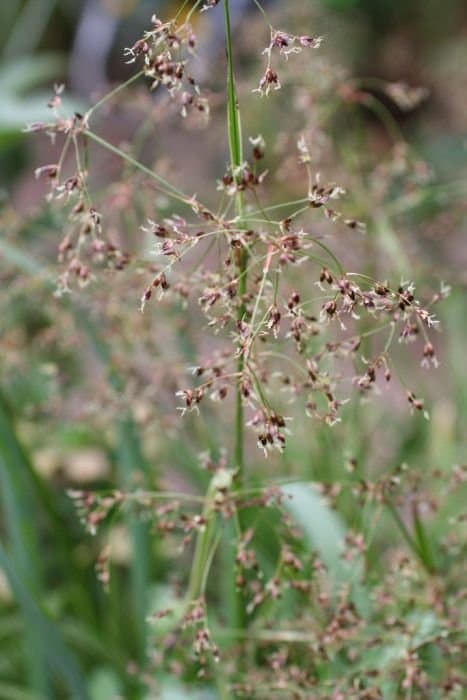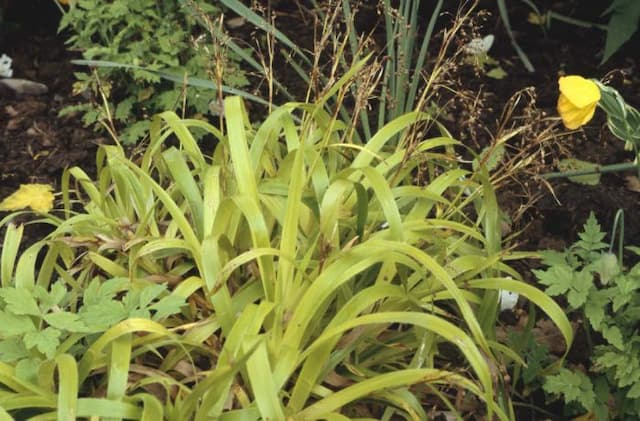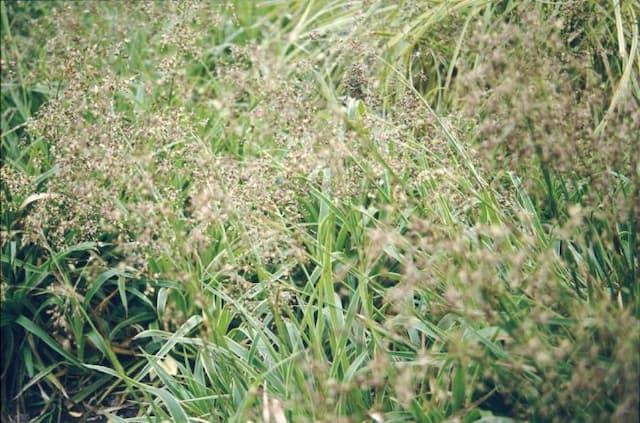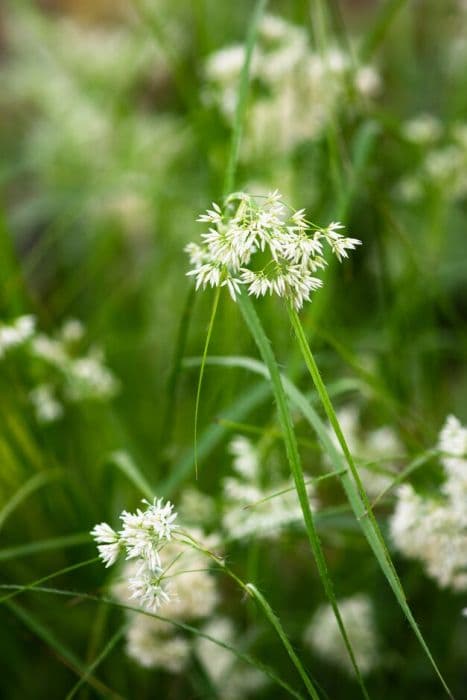Corkscrew rush Juncus effusus f. spiralis

ABOUT
The plant commonly known as corkscrew rush is a distinctive grass-like plant that immediately catches the eye thanks to its unusual foliage. The leaves of this plant are green and exhibit a unique spiraling or twisting form that resembles corkscrews, hence the name. These thin, wiry leaves emerge from the base of the plant and curl gracefully in all directions, creating a dense, tangled appearance that is both chaotic and aesthetically pleasing. The texture of the leaves is smooth, and they have a glossy appearance that can reflect light, giving the plant a subtle shimmering effect in bright conditions. Corkscrew rush doesn't bear conspicuous flowers; instead, it produces small, brownish or greenish flowers that are less noticeable, and which blend in with the leaves and stems. This ornamental plant typically adds a sense of movement and dynamism to garden settings due to the spiraling nature of its foliage. The color remains fairly consistent throughout the year, with some variation depending on seasonal changes and growing conditions. Corkscrew rush is often planted in gardens, pots, or around water features where its reflective leaves can contrast with the still water, highlighting the plant's one-of-a-kind form.
About this plant
 Names
NamesSynonyms
Corkscrew Rush, Spiral Rush, Twisted Arrows, Curly Wurly, Twister.
Common names
Juncus effusus var. spiralis, Juncus spiralis.
 Toxicity
ToxicityTo humans
Corkscrew rush is not considered toxic to humans. There are no well-documented reports of poisoning or toxic reactions from ingesting or contacting this plant. As with any non-food plant, it is generally advised not to ingest parts of the plant as they could potentially cause irritation or an allergic reaction in some individuals.
To pets
Corkscrew rush is not noted for being toxic to pets. It's not listed as a poisonous plant, and there should be no major concern if pets chew on it. However, ingestion of non-food plants can sometimes cause mild gastrointestinal upset in pets, such as vomiting or diarrhea, simply due to the ingestion of non-digestible material.
 Characteristics
CharacteristicsLife cycle
Perennials
Foliage type
Evergreen
Color of leaves
Green
Height
1-2 feet (30-60 cm)
Spread
1-2 feet (30-60 cm)
Plant type
Herb
Hardiness zones
4-9
Native area
Northern Hemisphere
Benefits
 General Benefits
General Benefits- Ornamental Value: Juncus effusus f. spiralis, commonly known as Corkscrew Rush, adds a unique visual interest to gardens with its spiraling, green stems.
- Water Garden Suitability: It thrives in wet conditions, making it an excellent choice for water gardens, ponds, and bog gardens.
- Low Maintenance: As a hardy and adaptable plant, Corkscrew Rush requires minimal care once established, making it ideal for busy or novice gardeners.
- Soil Erosion Control: Its dense growth habit can help stabilize soil and prevent erosion, particularly around water bodies.
- Habitat for Wildlife: The plant provides cover for small animals and insects, thus enhancing biodiversity.
- Adaptability: Corkscrew Rush is tolerant of a range of soil types, including heavy clay, which can be challenging for other plants.
 Medical Properties
Medical PropertiesThis plant is not used for medical purposes.
 Air-purifying Qualities
Air-purifying QualitiesThis plant is not specifically known for air purifying qualities.
 Other Uses
Other Uses- Corkscrew rush, with its ornamental spiraling stems, is often used in flower arrangements and floral designs to add a unique structural element.
- In landscape design, corkscrew rush is utilized around ponds and water features to enhance the naturalistic setting and provide visual interest with its distinctive growth habit.
- This plant can be used in eco-friendly biofilters or water purification systems in garden ponds where its roots help absorb excess nutrients and minerals from the water.
- Corkscrew rush can serve as a natural shelter and habitat for small wildlife, such as frogs and beneficial insects, within a garden environment.
- It is sometimes used in crafts and basketry; the stems can be woven to create intricate and naturally spiral-patterned items.
- In educational settings, corkscrew rush can be used to demonstrate plant adaptation and variegation as it is a prime example of unusual growth patterns in plants.
- The plant has potential use in preventing soil erosion around water bodies due to its bushy and fibrous root system that holds the soil together.
- Corkscrew rush is occasionally used as a curiosity plant in sensory gardens due to its texture and form, which can stimulate touch and vision.
- Some pet owners may use the non-toxic leaves of corkscrew rush for pet enclosures such as terrariums and vivariums to mimic natural habitats.
- During Christmas and other festive seasons, the uniquely shaped stems of corkscrew rush are sometimes incorporated into seasonal decorations and wreaths.
Interesting Facts
 Feng Shui
Feng ShuiCorkscrew rush is often used in Feng Shui for its upward spiraling growth, which can symbolize the ascension of energy, and may be placed in the wealth corner (southeast) of a home or business to attract prosperity.
 Zodiac Sign Compitability
Zodiac Sign CompitabilityThe Corkscrew rush is not used in astrology practice.
 Plant Symbolism
Plant Symbolism- Uniqueness and Individuality: Juncus effusus f. spiralis, also known as Corkscrew Rush, has a distinctive spiral growth pattern that symbolizes standing out from the crowd and embracing one's individuality.
- Flexibility and Adaptability: As Corkscrew Rush naturally grows in marshy environments which require adaptation, it can symbolize the ability to thrive in various conditions and adapt to life's changes.
- Balance and Harmony: The balanced, symmetrical spirals of the plant may represent the desire for balance and harmony in one's life.
- Humility: The simple appearance of Corkscrew Rush, despite its unique growth form, can symbolize humility and the beauty in simplicity.
- Vitality and Growth: Its vigorous growing nature and preference for wetlands can symbolize continuous growth and the vitality of life, even in challenging conditions.
 Water
WaterCorkscrew rush, commonly known as Juncus effusus f. spiralis, prefers consistent moisture and should be watered thoroughly when the top inch of soil feels dry to the touch. It can be watered once or twice a week, depending on the humidity and temperature, to maintain slight dampness in the soil. The plant thrives in boggy conditions, so it’s hard to overwater, but ensure it has good drainage to prevent root rot. Depending on the pot size, watering with 1-2 gallons every week should suffice to keep the soil consistently moist.
 Light
LightThe corkscrew rush does best in bright, indirect light or partial shade. It should be kept in a spot that receives several hours of filtered sunlight but is protected from the harsh afternoon sun. This plant can also tolerate full sun as long as it has sufficient water, but the ideal location is one where bright light is diffused to prevent scorching.
 Temperature
TemperatureCorkscrew rush can endure a wide range of temperatures; usually, it can survive in temperatures as low as 20°F but does best when temperatures are between 50°F and 70°F. It can tolerate heat above 70°F as long as there is ample moisture, but the ideal is to maintain a cooler environment for optimal growth. Ensure that plants are protected from extreme cold by bringing them indoors or providing insulation when temperatures drop significantly.
 Pruning
PruningPruning corkscrew rush is mainly to remove any brown or damaged leaves to maintain its appearance. The best time to prune is in the spring before new growth begins. It does not require heavy pruning; simply snip off any unsightly foliage. This helps encourage new, healthy growth and prevents potential disease from spreading through damaged leaves.
 Cleaning
CleaningAs needed
 Soil
SoilCorkscrew rush thrives in consistently moist, fertile soil with a slightly acidic to neutral pH of 6.0-7.0. A mix of two parts peat or coir, one part perlite, and one part sand can provide good water retention and aeration.
 Repotting
RepottingCorkscrew rush should be repotted every two to three years to refresh the soil and accommodate root growth.
 Humidity & Misting
Humidity & MistingCorkscrew rush prefers high humidity levels, but is adaptable and can tolerate a wide range of humidity conditions commonly found in home settings.
 Suitable locations
Suitable locationsIndoor
Place corkscrew rush in bright, indirect light with high humidity.
Outdoor
Plant in partial shade, ensure soil remains moist.
Hardiness zone
4-9 USDA
 Life cycle
Life cycleJuncus effusus f. spiralis, commonly known as Corkscrew Rush, begins its life cycle as a seed, which germinates in wet, marshy soil. Upon germination, the seedling emerges with its distinctive spiral growth habit and begins to develop a root system. The juvenile plant continues to grow, forming dense clumps of curly, green, wiry stems. Once mature, the Corkscrew Rush produces small, brownish flowers at the stem tips in the summer. After pollination, these flowers develop into small capsules containing numerous seeds which, when mature, are dispersed to begin a new generation. The plant does not have a distinct dormancy period but may die back in colder climates during winter, to then regrow in the spring.
 Propogation
PropogationPropogation time
Spring-summer
The Corkscrew Rush, or Juncus effusus f. spiralis, is often propagated by division, which is the most popular method for this ornamental grass. The ideal time for propagation by division is in the spring as the plant emerges from dormancy, which allows the divisions to establish during the growing season. To propagate by division, carefully lift the plant from the soil and use a sharp knife or spade to split the root clump into smaller sections, each with several healthy stems and an adequate amount of roots attached. These divisions should then be immediately replanted in moist soil, at the same depth they were previously growing, and watered thoroughly. Maintaining a consistent moisture level, without waterlogging, is key to ensuring successful establishment of the new plants.




